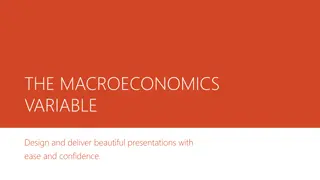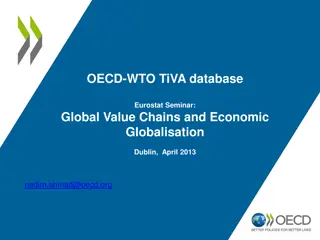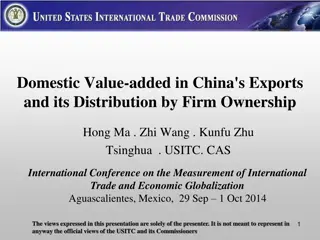Global Climate Models
Scientists simulate the climate system and project future scenarios by observing, measuring, and applying knowledge to computer models. These models represent Earth's surface and atmosphere using mathematical equations, which are converted to computer code. Supercomputers solve these equations to pr
3 views • 15 slides
ECC Social Value Reporting and Evaluation Framework
Essex County Council (ECC) has implemented a robust Social Value Reporting and Evaluation framework based on the Local Government Association's National TOMs method. This framework categorizes and assesses social value contributions in two parts - Value Score and Supporting Statement Score - to deri
3 views • 16 slides
System Models in Software Engineering: A Comprehensive Overview
System models play a crucial role in software engineering, aiding in understanding system functionality and communicating with customers. They include context models, behavioural models, data models, object models, and more, each offering unique perspectives on the system. Different types of system
3 views • 33 slides
Understanding Input-Output Models in Economics
Input-Output models, pioneered by Wassily Leontief, depict inter-industry relationships within an economy. These models analyze the dependencies between different sectors and have been utilized for studying agricultural production distribution, economic development planning, and impact analysis of i
8 views • 7 slides
Understanding Models of Teaching in Education
Exploring different models of teaching, such as Carroll's model, Proctor's model, and others, that guide educational activities and environments. These models specify learning outcomes, environmental conditions, performance criteria, and more to shape effective teaching practices. Functions of teach
2 views • 20 slides
Understanding Business Models and Pricing Strategies in Entrepreneurship
Explore the concept of business models and pricing in entrepreneurship, focusing on value creation versus value capture, different types of business models, such as the up-front charge model and transaction fee model. Learn how to monetize products or services based on the value provided to customer
0 views • 18 slides
Understanding Models of Teaching for Effective Learning
Models of teaching serve as instructional designs to facilitate students in acquiring knowledge, skills, and values by creating specific learning environments. Bruce Joyce and Marsha Weil classified teaching models into four families: Information Processing Models, Personal Models, Social Interactio
1 views • 28 slides
Significance of Models in Agricultural Geography
Models play a crucial role in various disciplines, including agricultural geography, by offering a simplified and hypothetical representation of complex phenomena. When used correctly, models help in understanding reality and empirical investigations, but misuse can lead to dangerous outcomes. Longm
0 views • 8 slides
Understanding CGE and DSGE Models: A Comparative Analysis
Explore the similarities between Computable General Equilibrium (CGE) models and Dynamic Stochastic General Equilibrium (DSGE) models, their equilibrium concepts, and the use of descriptive equilibria in empirical modeling. Learn how CGE and DSGE models simulate the operation of commodity and factor
4 views • 15 slides
Enhancing Information Retrieval with Augmented Generation Models
Augmented generation models, such as REALM and RAG, integrate retrieval and generation tasks to improve information retrieval processes. These models leverage background knowledge and language models to enhance recall and candidate generation. REALM focuses on concatenation and retrieval operations,
1 views • 9 slides
Understanding Item Response Theory in Measurement Models
Item Response Theory (IRT) is a statistical measurement model used to describe the relationship between responses on a given item and the underlying trait being measured. It allows for indirectly measuring unobservable variables using indicators and provides advantages such as independent ability es
2 views • 32 slides
Afghanistan Revenue Department Implements Value Added Tax
The Afghanistan Revenue Department has introduced Value Added Tax (VAT) as a step towards self-reliance and economic stability. The program aims to inform taxpayers about VAT, its purpose, implementation process, and impact on domestic revenues. By adopting VAT, Afghanistan aims to decrease reliance
0 views • 35 slides
Exploring Business Models in Entrepreneurship for Computer Science
Today's lecture covered the fundamentals of business models in entrepreneurship, emphasizing the importance of value creation and value capture. It discussed various types of business models, including the Up-Front Charge Model and the Transaction Fee Model, highlighting their respective features an
0 views • 18 slides
Overview of TRAIN Revenue Regulations No. 13-2018 on Value-Added Tax
These regulations under the Tax Reform for Acceleration and Inclusion (TRAIN) Act (RA 10963) focus on Value-Added Tax provisions, amending Revenue Regulations No. 16-2005. They cover zero-rated sales, VAT-exempt transactions, claims for input tax, refund procedures, and more. Conditions for VAT appl
1 views • 54 slides
Understanding Discrete Optimization in Mathematical Modeling
Discrete Optimization is a field of applied mathematics that uses techniques from combinatorics, graph theory, linear programming, and algorithms to solve optimization problems over discrete structures. This involves creating mathematical models, defining objective functions, decision variables, and
0 views • 12 slides
Understanding Value Added Tax (VAT) and Unemployment Insurance in Mathematical Literacy NQF Level 3
Dive into the realm of Value Added Tax (VAT) in South Africa, distinguishing between VAT-inclusive and VAT-exclusive pricing, and exploring the Unemployment Insurance Fund. Learn how to calculate VAT on exclusive prices and decipher payslips to enhance your mathematical literacy skills at NQF Level
0 views • 23 slides
Enhancing Social Value through Strategic Procurement
STAR Procurement, the shared service for multiple councils, emphasizes the importance of Social Value in procurement practices. The Social Value Portal serves as a management tool to measure and demonstrate the benefits of Social Value commitments. Bidders are required to provide quantitative and qu
0 views • 14 slides
Introduction to Lean Manufacturing Principles and Practices
Explore the fundamentals of Lean Manufacturing through a simulation-based course agenda at Mountain Pointe High School. From identifying value-added activities to eliminating waste, learn how to optimize processes to deliver value to customers efficiently. Dive into Lean principles, value stream map
0 views • 23 slides
Evaluating Bias in Value-Added Models Using Prior Scores
Outcome-based value-added (VA) models are commonly used to assess productivity in various fields. This study explores the use of prior scores to evaluate bias in VA estimates, focusing on the correlation between current teacher VA and lagged outcomes. The analysis highlights the sensitivity of balan
0 views • 38 slides
Observational Constraints on Viable f(R) Gravity Models Analysis
Investigating f(R) gravity models by extending the Einstein-Hilbert action with an arbitrary function f(R). Conditions for viable models include positive gravitational constants, stable cosmological perturbations, asymptotic behavior towards the ΛCDM model, stability of late-time de Sitter point, a
1 views • 12 slides
Value Chain Analysis in Agribusiness: Maximizing Value Addition and Product Distribution
Explore the application of the value chain concept in agribusiness by examining input supplies, production processes, wholesalers, distributors, retailers, and consumers for various primary products such as sheep, beef cow, dairy cow, and more. Understand the value-added products, processing methods
0 views • 5 slides
Integrated Value Creation in Corporate Finance
Explore the concept of integrated value creation in corporate finance, emphasizing the importance of managing for long-term value while incorporating social and environmental goals. Learn about responsible management practices that focus on creating net present value (NPV) through a balance of finan
0 views • 38 slides
Understanding Florida's Value-Added Model for Teacher Evaluation
Florida's Value-Added Model and the new standards for teacher evaluations aim to measure student learning growth effectively. The model, developed by Florida educators with input from various stakeholders, emphasizes using data from assessments to evaluate teacher performance. The Student Growth Imp
0 views • 28 slides
Analysis of Measuring Services and Value Added Shares in National Accounts
Measuring services in national accounts involves challenges due to the intangibility and heterogeneity of services. The estimation of output and prices is complex, especially in the fastest-growing sector of services. This analysis includes coverage of various industries and their NIC codes, as well
0 views • 26 slides
Understanding Information Retrieval Models and Processes
Delve into the world of information retrieval models with a focus on traditional approaches, main processes like indexing and retrieval, cases of one-term and multi-term queries, and the evolution of IR models from boolean to probabilistic and vector space models. Explore the concept of IR models, r
0 views • 65 slides
Flower Value Addition in Mamillapalli Thriveni
Value addition in flowers is a process that enhances the economic value and consumer appeal of floral commodities through genetic changes, processing, packaging diversification, and postharvest technology adoption. It not only boosts profitability but also serves as a rural development strategy, esp
0 views • 25 slides
Understanding E-Business: Origins, Factors, and Models
The content delves into the origins of e-business transactions, highlighting Electronic Funds Transfer (EFT), Electronic Data Interchange (EDI), and Value-Added Networks (VANs). It also explores unique e-business factors like disintermediation and reintermediation in various industries. Additionally
0 views • 22 slides
Understanding Cross-Classified Models in Multilevel Modelling
Cross-classified models in multilevel modelling involve non-hierarchical data structures where entities are classified within multiple categories. These models extend traditional nested multilevel models by accounting for complex relationships among data levels. Professor William Browne from the Uni
0 views • 13 slides
Actuarial Perspective on Value Added Benefits in Indian Health Insurance
Explore the viability and customer benefits of value added benefits in health insurance from an actuarial perspective at the 28th India Fellowship Seminar. The Indian healthcare industry's growth prospects, policy support, and the role of health insurance are discussed, highlighting the opportunitie
0 views • 21 slides
Understanding Macroeconomics: Key Concepts and Components
Dive into the world of macroeconomics with a focus on Gross Domestic Product (GDP), value added, circular flow of income, and expenditure components. Learn about the relationship between expenditure and income, the calculation of value added, and the distinction between final goods and intermediate
0 views • 22 slides
Understanding Nutritive Sweeteners and Added Sugars in the American Diet
Americans consume high amounts of added sugars daily, with teenagers accounting for a significant portion. Sugar intake has significantly increased over the years, leading to concerns about health implications. Various organizations recommend limiting added sugar intake to maintain overall health, e
1 views • 27 slides
Maximizing Shareholder Value Creation Through Strategic Business Practices
Explore the concept of shareholder value creation, the importance of generating revenues exceeding economic costs, and meeting shareholders' expectations. Learn about Economic Value Added (EVA), key value drivers, aligning strategy with value creation, and essential factors for overall business succ
0 views • 11 slides
Understanding Trade in Value-Added (TiVA) and Global Value Chains
Trade in Value-Added (TiVA) offers crucial insights into the complexities of global value chains and economic globalization. By shifting focus from gross trade statistics to value creation along supply chains, TiVA helps in formulating better policies and addressing systemic risks associated with ma
0 views • 22 slides
Outdoor Recreation Satellite Account: National Statistics 2012-2020 Briefing
The Outdoor Recreation Satellite Account (ORSA) provides comprehensive data on outdoor recreation in the U.S. from 2012 to 2020. The main updates include new data for 2020, revised data for previous years, and incorporation of various data sources. The top-line data for 2020 shows the significant ec
0 views • 16 slides
Understanding Trade in Value Added: Key Insights from Joint UNCTAD-UNECA Seminar
Explore the complex world of Regional and Global Value Chains (RVCs/GVCs) in services and trade, presented at a seminar by Ben Shepherd, focusing on the importance of measuring trade in value added for a more accurate economic picture. Discover key takeaways, data requirements, and the rationale beh
0 views • 20 slides
Understanding Composite Models in Building Complex Systems
Composite models are essential in representing complex entities by combining different types of models, such as resource allocation, transport, and assembly models. Gluing these models together allows for a comprehensive representation of systems like the milk industry, where raw materials are trans
0 views • 27 slides
Internet Integration for Manufacturing Upgrading in China
This work explores how manufacturing firms in China can leverage internet integration to reinvent competitive advantages in the industrial chain. It discusses the impact of internet technology on firm behaviors, value-added product distribution, and the Smiling Curve theory. The study delves into ke
0 views • 13 slides
Analysis of Domestic Value-Added in China's Exports by Firm Ownership
This study delves into the distribution of domestic value-added in China's exports based on firm ownership types. By decomposing gross exports into domestic and foreign value-added, it aims to understand how value is distributed among different factor owners to quantify the generated gross national
0 views • 22 slides
Exploring the Added Value Unit at National 4 Level
The Added Value Unit (AVU) at National 4 level focuses on investigating and reporting on a person you admire through two texts. This unit challenges English skills by requiring the evaluation of texts and selection of relevant information for the report. Skills tested include research, analysis, ind
0 views • 13 slides
Business Model Reporting for Value Creation
Integrated Reporting (IR) plays a crucial role in forging business partnerships and facilitating sound decision-making. Understanding the organizational business model is essential for long-term sustainability and value creation. The global approach to business model reporting encompasses business s
0 views • 42 slides







































